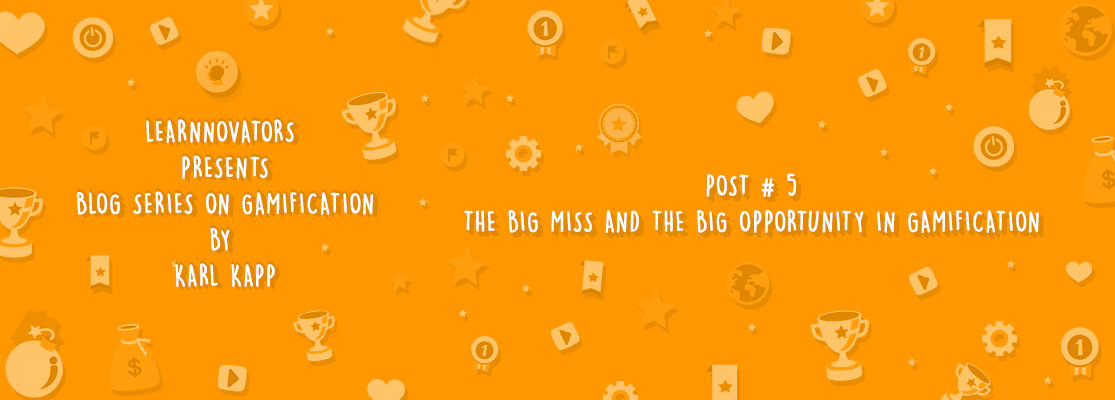THE BIG MISS AND THE BIG OPPORTUNITY IN GAMIFICATION
This is the fifth and final post in a series of articles about gamification written by Karl Kapp exclusively for Learnnovators. The first post in the series, GAMIFICATION FOR CORPORATE LEARNING, provided a definition of gamification, and further explained its two types. The second post, AVOID THESE GAMIFICATION PITFALLS, discussed the common pitfalls of gamification and how an organization can avoid them. The third post, THE LEARNING IN GAMIFICATION, covered the elements of gamification that can make learning effective. While the fourth post said that GAMIFICATION IS ABOUT ENGAGEMENT, this final post discusses the big miss and the big opportunity in gamification.
Many corporations are implementing structural gamification in the form of a platform with points, badges and leaderboards awarded to learners for learning specific, pre-determined content. Additionally, companies are also implementing content gamification in many areas in the form of game elements such as story and feedback to provide gamified experiences on everything from leadership training to training retail associates. These organizations are mostly successful and have seen some pretty dramatic results from their gamification efforts; however, they are missing one big gamification opportunity. This type of gamification opportunity goes beyond teaching through games to solving problems with games.
The opportunity corporations are missing is the chance to solve big intractable problems by gamifying and crowdsourcing those problems. Organizations should take gamification one step further and use the concept for new and creative avenues. Here are a couple of examples of using gamification to solve problems.
MMOWGLI
At the height of the Somali pirate reign of terror on ships from around the world, the United States military launched a gamified solution to generate new ideas on how to battle the pirates through the use of a massive multiplayer game. The initiative involved the military creating a game-based environment and crowdsourcing military solutions from civilians. The goal was to find innovative solutions by observing what players do within the game environment and leveraging those actions to defeat the pirates.
The message-based game platform is called Massive Multiplayer Online War Game Leveraging the Internet (MMOWGLI) and it had online players from all over the world who immersed themselves in the online game environment to focus on defeating the efforts of the Somali pirates. During the message-based gameplay, players negotiated the logistics of arming ships, determining the likelihood of pirate attacks and carefully considering the financial, jurisdictional and temporal difficulties of military action needed to support commercial shipping and cruise ships.
This was a unique use of gamification, and it was the first time the American military had integrated crowdsourcing and gamification into traditional military wargames. Today, the concept has expanded to include non-military strategies and an examination of geopolitical problems around the world.
The MMOWGLI platform is designed specifically to allow for massive collaboration on complex problems. Then when the situations are being played out during the game, monitors of the system try to surface outliner strategies that seem particularly effective or promising. Since helping to battle the piracy problem, the platform has been adapted to a variety of situations and is even being used to examine what might happen after the first ever ice free Artic summer as a result of global warming (they are predicting a land grab situation.) You can learn more at www.portal.mmowgli.nps.edu.
FOLDIT
Another example of using gamification to solve a large, intractable problem is the phenomenon of Foldit.
Foldit is an online puzzle video game about protein folding. It was an experimental research project developed ty the University of Washingtons Center for Games Science in collaboration with the UW Department of Biochemistry. The Foldit project is a gamified problem-solving scenario where players try to fold the structures of selected proteins as much as possible using the tools included in the game. Players earn points and can climb leaderboards. Scientists then use the configurations to help solve real world problems. For example, in 2011 the players of Foldit helped to decipher a protein related to an AIDS-causing virus that had been unsolvable for 15 years.
These are just two examples of the power of gamification to solve complex and difficult problems.
THE OPPORTUNITY
So, rather than thinking about gamification in the narrow vein of gamifying learning for better training results, learning and development professionals should seriously consider teaming with research and development or other innovative departments to consider how to create new and exciting products or figure out how to tap into a new market or even how to solve problems they didnt know their customers were having.
Imagine a scenario where your customers could play a gamified version of your product and could modify or change your product as they needed in a virtual environment to solve the problems they are having today and foresee having in the future. In fact, your customers who are playing with a gamified version of your product could actually be your R&D department who can help guide innovative product developments. L&D professionals are all about creativity and innovation as well as helping employees to prepare for the future. A gamified platform of your product used in a crowdsourcing way to solve customers problems is the right next step in the gamification efforts of the corporation.Here are links to all five posts from this series:
1. Gamification For Corporate Learning
2. Avoid These Gamification Pitfalls
3. The Learning In Gamification
4. Gamification Is About Engagement
5. The Big Miss And The Big Opportunity In Gamification
Written by Karl Kapp
_________________________________
Published on 12-Oct-2016






